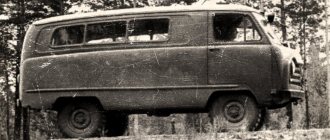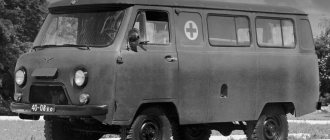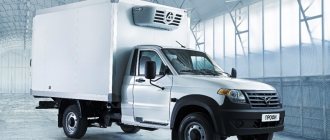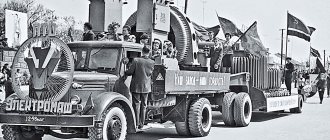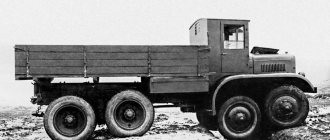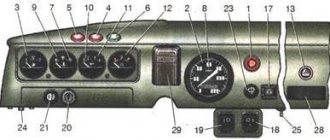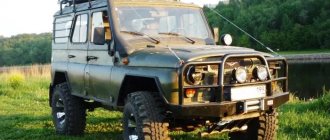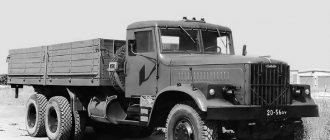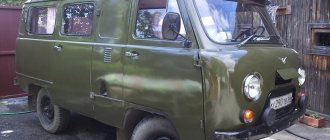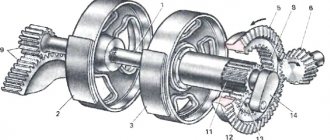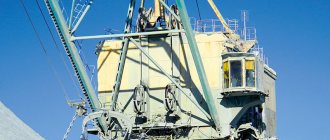| UAZ-452 | |
| Manufacturer | UAZ |
| Years of production | 1965–present |
| Assembly | UAZ (Ulyanovsk, USSR) UAZ (Ulyanovsk, Russia) |
| Body type | Van, Minibus |
| Layout | front-engine, all-wheel drive |
| Wheel formula | 4 × 4 |
| Volume | 2445 cm3 |
| Maximum power | 98 l. s., at 4000 rpm |
| Maximum torque | 182 Nm, at 2500 rpm |
| Configuration | in-line, 4-cylinder. |
| Cylinders | 4 |
| Valves | 8 |
| Max. speed | 110 |
| Combined fuel consumption | 17,5 |
| Cylinder diameter | 92 mm |
| Piston stroke | 92 mm |
| Compression ratio | 8,2 |
| Supply system | carburetor K-129V |
| Cooling | liquid |
| Cylinder block material | aluminum |
| Cylinder head material | aluminum |
| Clock (number of clock cycles) | 4 |
| Cylinder operating order | 1-2-4-3 |
| Recommended fuel | AI-92 |
| ZMZ-40911 | |
| Manufacturer | ZMZ |
| Type | injection |
| Volume | 2693 cm3 |
| Maximum power | 112 l. s., at 4250 rpm |
| Maximum torque | 198 Nm, at 2500 rpm |
| Configuration | in-line, 4-cylinder. |
| Cylinders | 4 |
| Valves | 16 |
| Max. speed | 127 |
| Combined fuel consumption | 14 |
| Cylinder diameter | 95.5 mm |
| Piston stroke | 94 mm |
| Compression ratio | 9 |
| Supply system | injection |
| Cooling | liquid |
| Cylinder block material | cast iron |
| Cylinder head material | aluminum |
| Clock (number of clock cycles) | 4 |
| Cylinder operating order | 1-2-4-3 |
| Recommended fuel | AI-92 |
UAZ-2206/3741/3909/39094/3962/3303
- a family of Soviet and Russian all-wheel drive cargo and passenger off-road vehicles produced at the Ulyanovsk Automobile Plant. Serial production of the UAZ-452 began in 1965.
UAZ-450B - headquarters on wheels
In 1956, the Ulyanovsk Automobile Plant received a special order from the Automotive Directorate of the Armed Forces of the USSR to develop a mobile headquarters based on the first independent series of the automobile plant's model - the UAZ-450. The new product was called UAZ-450B and three prototypes were produced for testing.
Prototype headquarters on wheels UAZ-450B
Externally, the newly-made headquarters on wheels was no different from the basic UAZ-450 model, but the interior had a complete set for performing the functions assigned to the vehicle: folding tables with table lamps, a clock and additional autonomous heaters in case of need to work in severe frost. There was even a safe in the cabin of the UAZ-450B for storing documents.
Tests showed that there was not enough space in the interior of the headquarters minibus, so all work on this project was stopped.
Tuning individual interior elements
Individual elements of the interior are also being modernized in the UAZ. For example, you can modify the hood (lid) of the engine compartment by installing a cover or minibar on top of it. Now you can place some things on top of the engine, and they won’t go anywhere while the car is moving.
Also, auto tuning stores sell special insulating caps for the engine cover. This upholstery will somewhat improve the noise and heat insulation in the cabin, and the bonnet looks very aesthetically pleasing.
UAZ-452 - fitting room
The UAZ company shared this photo on social networks, saying that the photo was found in the corporate archive. Even the modern office of the Ulyanovsk plant was surprised by the fact that such a version of the van based on the “Loaf” existed.
Fitting room based on UAZ-452 “Loaf”
A UAZ-452 all-wheel drive van with single doors on the sides and a double door at the rear was used instead of a fitting room. The photo shows a car with a beige body color with a characteristic orange stripe. The date of the photo is not reported, just as there is no information about the presence of modifications in the salon for the convenience of trying on clothes.
Van
Dimensions of UAZ Bukhanka Van
| Number of seats | 2 |
| Curb weight, kg | 1 805 |
| Total weight, kg | 2 730 |
| Load capacity, kg | 925 |
| Length, mm | 4 390 |
| Width (with/without mirrors), mm | 1 940/2 170 |
| Height, mm | 2 064 |
| Wheelbase, mm | 2 300 |
| Front and rear wheel track, mm | 1 465 |
| Ground clearance (to bridge), mm | 205 |
| Wheel disks | 6.5Jх16Н2 |
| Tires | 225/75R16 |
| Fuel tank volume, l | 50+27 |
UAZ-451C - tracked snowmobile
Developed in 1960, a rare modification of the “Loaf” in the form of an onboard van-snowmobile with triangular rubber-metal tracks on the rear axle and a massive superstructure in the form of steerable skis at the front was used to move through snowy terrain where it was impossible to drive a regular car.
Tuning UAZ-451S: with skis and tracks
In addition to high cross-country ability in snowdrifts, the main feature of the rear-wheel drive UAZ-451C snowmobile was the reversibility of modifications - two people could install the standard chassis back within an hour. Snowmobile parts of the tuned modification, at the same time, could be transported directly in the back of the flatbed.
UAZ-451S with skis and tracks
UAZ-451S with skis and tracks
The total weight of the modified car was 3063 kg, and the maximum speed on snow cover was 20 km/h. How many of these snowmobiles were produced is unknown.
Onboard
Dimensions of UAZ Bukhanka Onboard
| Number of seats | 2 |
| Curb weight, kg | 1 845 |
| Total weight, kg | 3 070 |
| Load capacity, kg | 1 225 |
| Length, mm | 4 501 |
| Width (with/without mirrors), mm | 1 940/2 170 |
| Height, mm | 2 355 |
| Wheelbase, mm | 2 550 |
| Front and rear wheel track, mm | 1 465 |
| Ground clearance (to bridge), mm | 205 |
| Fording depth, mm | 500 |
| Wheel disks | 6.5Jх16Н2 |
| Tires | 225/75R16 |
| Fuel tank volume, l | 50 |
UVZ-2 and UVZ-4.8 with a jet engine
The modifications of the “Loaf”, which later received the names UVZ-2 and UVZ-4.8 (UVZ is an abbreviation for “air launch unit”), are probably the most unusual of all the experimental versions that were created on the basis of this car. At some point, UAZ engineers decided that it would be nice to equip the UAZ-452/3741 van with a rocket engine. No sooner said than done.
Air launch unit UVZ-4.8
It was possible to fit a single-shaft gas turbine engine inside the “Loaf”, but to do this it was necessary to sacrifice all the free space in the body and make significant changes to the usual controls. The steering wheel also began to serve as a gear switch, and instead of the passenger seat in front, engineers placed a control panel for the gas turbine engine and auxiliary equipment for its startup and operation.
Air launch unit UVZ-4.8
The tuned “Loaf” differed from the usual versions of the UAZ-452/3741 from the outside by a massive front bumper and, in combination, a storage tray for a 12-meter flexible hose used to supply compressed air, air intake blinds instead of side windows, a special exhaust hatch on the roof, etc. or - an emergency warning light chandelier. There was also a fire extinguisher located outside the jet car just behind the driver's door.
Air launch unit UVZ-4.8
The list of additional equipment of the “Loaf” with an aircraft engine included a radio station and an automatic fire extinguishing system, which was triggered in the event of a sharp increase in temperature in the cabin. The expensive experimental jet "Loaf" was mainly used for ground-based air starting of aircraft engines (for example, Il-62 and Tu-154). Special vehicles UV3-2 and UV3-4.8 provided the aircraft's air starter turbines with compressed air and fed their on-board electrical network with current.
Basic configurations
The cost of the standard version of the UAZ “Bukhanka” (Kombi version) with 5 seats is 708 thousand rubles. Two additional seats will cost another 3 thousand rubles. Thus, the standard model for Russia assumes the presence of:
- 2.7-liter “atmospheric” engine;
- 5-speed manual transmission;
- transfer case with reduction gear;
- permanent all-wheel drive;
- rear fog lights;
- halogen head optics;
- sockets;
- anti-lock braking system;
- seat belts located near the front seats;
- full-size spare wheel.
Power steering with the Combi version is available as an option. A folding table is installed as standard in the cabin. For an additional fee of 5 thousand rubles. you can get a similar car that has a glass rear door and hydraulic power steering. With all modifications, except the top one, heated front row seats and a locking rear axle differential are optionally available. The default seat covering is fabric.
KMZ-T12.02 – car club
This unusual modification based on the UAZ-3303 SUV was developed during the Soviet era for propaganda work with the goal of communist education of the population. Culture and art were one of the simple ways to form among the population values and ways of thinking that were convenient for the authorities. A convenient means of conveying the necessary thoughts to residents of remote villages was the auto club modification T12.02, which went into mass production in 1987 (however, pre-production versions have existed since 1980).
KMZ-T12.02
Such rotational buses were produced in various modifications, of which the five-seater T12.02, seven-seater T12.02A and eight-seater T12.02B were particularly popular. The equipment of the models varied greatly in composition depending on the specific purpose. All-terrain auto clubs were equipped with tape recorders, film installations, sound amplifiers with acoustics, and photo and video equipment. In such cars, concert groups traveled to remote villages and performed in front of workers and residents of these settlements. Car clubs also brought movies.
KMZ-T12.02
From a technical point of view, auto clubs differed from the base “Kuban” in their larger interior and high ceilings, which also became the reason for their indirect use as a regular means of transportation, which simply became more convenient after tuning. The only fly in the ointment was the separated driver's cabin and interior, which was not to everyone's liking. Because of this, in 1992 the design was revised by removing the wall between the passenger compartment and the driver's cabin. This modification was called TSK2, and auto club versions based on it were TSK2-02 and TSK2-09.
Minibus TSK2
It is interesting that the first versions of auto clubs began to be produced at the Krasnodar Mechanical Plant back in 1967, based on the UAZ-452D chassis, but this design did not take root due to the lack of manufacturability and a low and narrow body. Car clubs T12.02 on the UAZ-3303-1 chassis solved all the shortcomings of the previous base.
Review
The loaf was modernized extremely slowly, which was facilitated by the absence of any government regulations in this regard.
Moreover, the “loaves” consistently found buyers, this time, exclusively thanks to massive government orders. The situation began to change only at the end of the “perestroika” 80s, when the Ulyanovsk Automobile Plant made minor modifications to the chassis: changed the gear ratios in the axles, installed dual-circuit brake drives, and boosted the engine.
Salon
During the same period, it was decided to change the designations of numerous versions of the Bukhanka: the car in the form of a minibus began to be called UAZ-2206, the flatbed truck received the designation UAZ-3303, the van - UAZ-3741, and the medical vehicle - UAZ-3962.
Technical stuffing
For 20 years after the start of production, the UAZ Bukhanka had the status of a military vehicle (the original idea was to create equipment designed to remove those killed from the affected area after the explosion of enemy bombs).
In the 60s, the cabover UAZ Bukhanki had its frame changed, telescopic shock absorbers installed, and a 2.5-liter (70 hp) GAZ-21 Volga engine was used as a power plant.
This car received a new engine much later: in 1997, the “loaves” began to be equipped with 2.9-liter 98-horsepower UMZ-4218 units, which 20 years later were modernized to comply with Euro-3 standards.
SGR - Trophy.
A few more years - and these engines were brought to the Euro-4 level, and the car itself began to receive modern systems, such as power steering or an ABS system. Today, the main engine for the UAZ Bukhanok 2022 is considered to be the ZMZ-40911 engine (2.7 liters, 112 hp) with fuel injection.
Source
Ten-seater UAZ-37411
Such an experimental model based on the UAZ-37411 was manufactured for the needs of the USSR Ministry of Defense in 1990. When developing the project, the engineers of the Ulyanovsk Automobile Plant were faced with the task of making a car based on the production model, so no deep modifications were carried out.
Ten-seat modification of UAZ-37411 (experimental model)
The roof and sides of the commercial UAZ-37411 were cut off, starting from the driver’s cabin, and the doorways that turned out to be superfluous were welded shut. Two four-seater benches were placed in the cabin, and an awning was supposed to protect passengers from bad weather. To install the latter, a welded frame made of a round pipe was mounted, and to fix the edges of the awning, fastenings were made along the top of the cut sides and the tailgate.
Ten-seat modification of UAZ-37411 (experimental model)
Ten-seat modification of UAZ-37411 (experimental model)
In addition, the experimental ten-seater model UAZ-37411 acquired a power front bumper, a partition for the driver's cabin with a sliding window and a heating system for the cargo compartment. All these “bonuses” to complete the tuning were borrowed from the ambulance version of the UAZ-3962 car.
Installing the front seats
The “original” front passenger and driver seats are simply terrible in their design and quality, and UAZ car owners try to replace them first. In a car used for hunting and fishing, the driver has to sit behind the wheel for a long time, and on such “seats” the back and lower back instantly become numb, and the person sitting on them quickly gets tired.
UAZ drivers do not repair and improve their original seats; they immediately replace the seats with “foreign” ones, or install them from a Russian passenger car. But any seats will not fit on the UAZ Bukhanka; the seats are too wide and high and will not fit in the cabin. The least adjustments to the mountings are required by the “seats” of the car models:
- VAZ 2108-09-099;
- VAZ-11113 “Oka”;
- Opel Corsa;
- Honda Civic;
- Moskvich-2141;
- Nissan Micra;
- Volkswagen Passat B3.
For the “Loaf” you can choose seats from other models; here the price is also of no small importance. It should be noted right away that almost no one installs new seats on UAZs; car owners try to buy “seats” at car dismantling yards or through advertisements from private owners.
Soap boxes for signalmen
“Tadpole”: a new “Loaf” with an onboard platform was shown on the Internet
This unusual tuning of the “Loaf” based on the UAZ-452D chassis differs from many others primarily in that the car was designed and created not under government orders, but on its own initiative and on its own by the Karelian Territorial Center for Long-Distance Communications and Television No. 23 (TCMC-23) — branch of OJSC Rostelecom. At some point, the center had a need for a cargo-passenger van that would become an assistant in servicing cable communication lines in the North-West region of the country. No sooner said than done.
In 1977, the first model of a vehicle for signalmen appeared, developed by the designers of TTsMS-23 and designated RPK-23. Subsequently, this modification will receive the popular name “Soap Dish” due to the rounded shape of the roof. A fiberglass body without a frame was installed on the chassis from the UAZ-452D, and six passenger seats were installed inside (excluding one more next to the driver), as well as tool boxes. Throughout 1978, the car was tested and the USSR Ministry of Communications recommended it for mass production.
UAZ RPK-23
UAZ RPK-23
The fiberglass body was ordered from the Baltic fishing collective farms, which have their own individual production of boats from this material. The RPK-23 “loaves” for signalmen have proven themselves in operation. The fiberglass body significantly reduced the weight of the car and did not rust. But there were also a lot of disadvantages - increased windage and a constant smell of epoxy resin in the cabin - it was used to glue the fiberglass together.
UAZ "Loaf" RPK-23
To get rid of these shortcomings, in 1984 a modification of the RPK-23M appeared, the roof of which was lower, the interior was smaller, and the fiberglass panels were now manufactured in the own polymer workshop of the Karelian Communications Center. After the collapse of the USSR, the need to use this vehicle gradually disappeared.
Farm modification RPK-23-2M
In total, about 450 of these vehicles were produced, including later “farm” modifications (for example, RPK-23-2M) with an onboard wooden platform and a double cab on a UAZ chassis, developed as an attempt to maintain demand. But, alas.
Combi
Dimensions of UAZ Bukhanka Combi
| Number of seats | 5 |
| Curb weight, kg | 1 890 |
| Total weight, kg | 2 830 |
| Load capacity, kg | 940 |
| Length, mm | 4 390 |
| Width (with/without mirrors), mm | 1 940/2 170 |
| Height, mm | 2 064 |
| Wheelbase, mm | 2 300 |
| Front and rear wheel track, mm | 1 465 |
| Ground clearance (to bridge), mm | 205 |
| Fording depth, mm | 500 |
| Wheel disks | 6.5Jх16Н2 |
| Tires | 225/75R16 |
| Fuel tank volume, l | 50+27 |
Seam filler DS-67A
This hard worker, based on the “Loaf” modification of the UAZ-452D, was used for repairing and laying asphalt pavement for cement-concrete surfaces of roads and airfields. The main purpose of the restoration vehicle was to fill seams. A car called DS-67A was produced.
Seam filler UAZ DS-67A
An interesting feature of this workhorse was the heating of bitumen mastic by car exhaust gases. In a boiler with a volume of 150 liters, the mastic was heated to an operating temperature of 160 - 180 degrees Celsius. The composition was applied to the asphalt surface using a mastic pipe with a nozzle, and the pressure in the system was created by a compressor. In order for the mastic to flow better into the road seams during operation, it was heated with liquid fuel burners. In one shift, using the DS-67A, it was possible to fill up to 1,400 meters of road joints.
Glazed van
Dimensions of UAZ Bukhanka Glazed van
| Number of seats | 5 |
| Curb weight, kg | 1 920 |
| Total weight, kg | 2 845 |
| Load capacity, kg | 925 |
| Length, mm | 4 390 |
| Width (with/without mirrors), mm | 1 940/2 170 |
| Height, mm | 2 064 |
| Wheelbase, mm | 2 300 |
| Front and rear wheel track, mm | 1 465 |
| Ground clearance (to bridge), mm | 205 |
| Wheel disks | 6.5Jх16Н2 |
| Tires | 225/75R16 |
| Fuel tank volume, l | 50+27 |
Reanimation vehicle "Medea"
The Russians spent two million rubles on tuning the UAZ “Bukhanka”
Another interesting tuning project based on the “Loaf” was named “Medea” in honor of the sorceress and founder of medicine from ancient Greek mythology. The all-terrain vehicle was used for the needs of Georgian mountain rescuers as a resuscitation vehicle and was developed on the basis of the experimental three-axle minibus UAZ-452K with a 6x6 wheel arrangement, invented by UAZ designers back in 1973.
In addition to the three-axle “trolley” (the connection diagram of the third axle of which was similar to that of the ZIL-157), the car differed from the usual “Loaves” by an enlarged body and a raised roof. The spacious cabin contained all the equipment necessary for resuscitation measures.
The production of such cars was carried out by the All-terrain vehicle cooperative in the city of Bolnisi, Georgia. In total, about 500 Medea Ambulance Loaves were produced between 1989 and 1994. The further fate of the cooperative is unknown.
Reanimobile UAZ Medea
Combi Trophy
Dimensions of UAZ Bukhanka Combi Trophy
| Number of seats | 7 |
| Curb weight, kg | 1 890/1 920 |
| Total weight, kg | 2 830 |
| Load capacity, kg | 861 |
| Length, mm | 4 390 |
| Width (with/without mirrors), mm | 1 940/2 170 |
| Height, mm | 2 266 |
| Wheelbase, mm | 2 300 |
| Front and rear wheel track, mm | 1 465 |
| Ground clearance (to bridge), mm | 205 |
| Fording depth, mm | 500 |
| Wheel disks | 6.5Jх16Н2 |
| Tires | 225/75R16 |
| Fuel tank volume, l | 50+27 |
Ice filling machine
When it comes to highly specialized projects, there is not always room for design. This “scarecrow” based on the UAZ-452, after significant modifications, was transformed into an ice-filling combine. In the mini-booth, where the driver’s seat used to be, only the steering wheel remains, and the vehicle control itself has moved to the stern, in line with modern combine harvesters.
Tuning UAZ “Bukhanki”: ice filling combine
The steering wheel at the rear of the body was connected to the standard steering wheel by a universal joint and a long shaft. To prevent the marvels of engineering from being borrowed by spies, instead of glass there were blind plugs matching the color of the body. Ice resurfacing machines based on the UAZ-452 were produced from 1960 to 1970 and were good helpers in ice arenas many years after production ceased.
Farmer
Dimensions of UAZ Bukhanka Farmer
| Number of seats | 5 |
| Curb weight, kg | 1 995 |
| Total weight, kg | 3 070 |
| Load capacity, kg | 1 075 |
| Length, mm | 4 847 |
| Width (with/without mirrors), mm | 1 940/2 170 |
| Height, mm | 2,355 (for awning) |
| Wheelbase, mm | 2 550 |
| Front and rear wheel track, mm | 1 465 |
| Ground clearance (to bridge), mm | 205 |
| Fording depth, mm | 500 |
| Wheel disks | 6.5Jх16Н2 |
| Tires | 225/75R16 |
| Fuel tank volume, l | 50 |
Passenger ladder SPT-20
UAZ “Loaves” worked everywhere and what modifications were born when it was necessary to solve certain problems. Thus, there were even SPT-20 passenger ramps on a modified UAZ-452D chassis, the main functionality of which was to assist in boarding and disembarking passengers from aircraft.
Passenger ladder SPT-20
The ladder of the SPT-20 ladder was designed with a fixed angle of inclination, and the vehicle was driven by one driver and part-time operator. The ladder had a retractable section with a standard landing platform, and for servicing aircraft with a two-meter height of the passenger door threshold there was an additional landing platform.
These vehicles were mainly used in the northern regions of the country, where the use of battery-powered ladders caused some inconvenience.
